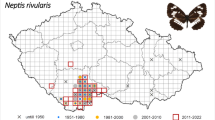Abstract
The Japanese monkey (Macaca fuscata) winter range utilization and the effects of foraging on mulberry trees (Morus bombycis) were studied in the Shimokita Peninsula during four winter seasons. The monkeys ate mainly winter dormancy buds when they visited the mulberry tree clumps for the first time within the winter, but they ate mainly bark when they visited for the second or third times. In the areas utilized by the monkeys over the recent three years, the mulberry trees compensated for the decrease in their number of shoots by producing longer shoots with more buds against the monkey foraging. In the areas used every year for more than four years, however, the mulberry trees were unable to compensate for the foraging pressure. Thus, although the monkeys had apparently operated prudent herbivory within three years, they did not do so on a longer time-scale. They shifted their utilization ranges after having over-exploited the mulberry trees.
Similar content being viewed by others
References
Ashizawa, S., 1976. Japanese monkeys in Shimokita: troop movement in winter and the change of forests.Monkey, 145–146: 6–11. (in Japanese)
————, 1984. Following monkeys in winter mountains. In:Monkeys in Shimokita,K. Izawa (ed.), Doubutsusya, Tokyo, pp. 55–105. (in Japanese)
Belsky, A. J., 1986. Does herbivory benefit plants?: a review of the evidence.Amer. Naturalist, 127: 870–892.
Brown, B. J. &T. F. H. Allen, 1989. The importance of scale in evaluating herbivory impacts.Oikos, 54: 189–194.
Danell, K., K. Huss-Danell, &R. Bergström, 1985. Interactions between browsing moose and two species of birch in Sweden.Ecology, 66: 1867–1878.
Hilbert, D. W., D. M. Swift, J. K. Detling, &M. I. Dyer, 1981. Relative growth rates and the grazing optimization hypothesis.Oecologia, 51: 14–18.
Izawa, K., 1971. Japanese monkeys living in the Okoppe basin of the Shimokita Peninsula: the first report of the winter follow-up survey after the aerial spraying of herbicide.Primates, 12: 191–200.
Martin, P. &P. Bateson, 1986.Measuring Behaviour. Cambridge Univ. Press, Cambridge.
McNaughton, S. J., 1979. Grazing as an optimization process: grass-ungulate relationships in the Serengeti.Amer. Naturalist, 113: 691–703.
————, 1983. Compensatory plant growth as a response to herbivory.Oikos, 40: 329–336.
Nakagawa, N., 1989. Feeding strategies of Japanese monkeys against deterioration of habitat quality.Primates, 30: 1–16.
Nakayama, Y., 1986. Foraging behavior of Japanese monkeys on mulberry trees. M.Sc. thesis, Hokkaido Univ., Hokkaido. (Unpubl. in Japanese)
Owen, D. F., 1980. How plants may benefit from animals that eat them.Oikos, 35: 230–235.
———— &R. G. Wiegert, 1976. Do consumers maximize fitness?Oikos, 27: 488–492.
———— & ————, 1981. Mutualism between grasses and grazers: an evolutionary hypothesis.Oikos, 36: 376–378.
Paige, K. N. &T. G. Witham, 1987. Overcompensation in response to mammalian herbivory: the advantage of being eaten.Amer. Naturalist, 129: 406–417.
Wada, K., 1964. Some observations on the life of monkeys in the snowy district of Japan.Physiol. Ecol., 16: 15–23. (in Japanese)
————, 1983. Long-term changes in the winter home ranges of Japanese monkeys in the Shiga heights.Primates, 24: 303–317.
Author information
Authors and Affiliations
About this article
Cite this article
Watanuki, Y., Nakayama, Y., Azuma, S. et al. Foraging on buds and bark of mulberry trees by Japanese monkeys and their range utilization. Primates 35, 15–24 (1994). https://doi.org/10.1007/BF02381482
Received:
Accepted:
Issue Date:
DOI: https://doi.org/10.1007/BF02381482




